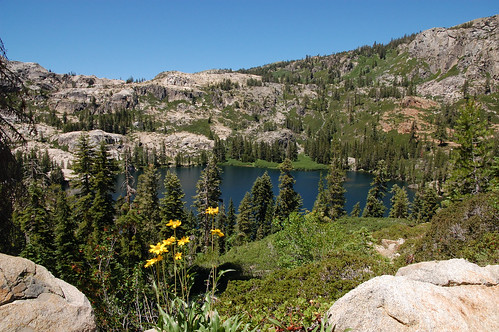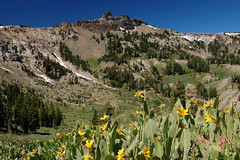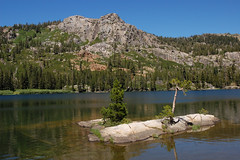
Tantalizingly Close to Warren Lake
My friend Erik and I decided to go hiking on Saturday. He suggested we take the Rockbound Pass Trail in the Desolation Wilderness, but I hiked that trail twice last summer, and was interested in something new. I checked _California Hiking_ and found one trail that was close enough to drive to for a day hike, was a challenge in terms of length and difficulty (which I was looking for), and promised to be a beautiful hike (the book gave it a 10 for scenic value): Warren Lake Trail.
I suggested it to Erik and sent him a link to a photo of the lake, thinking he would just trust me about it being suitable. But instead he looked up information online about the hike and found it was described as "very difficult," and recommended only as a 2-day backpacking trip.
Of course, that hike on Rockbound Pass Trail to the lakes just past the pass is also described as a 2-day backpacking trip, as is the one we had made a couple of weeks earlier to Rubicon Lake. That hike was 16.2 miles, whereas this one was listed in my book and online as 14 miles (turns out it is 15). None of the descriptions were too exact, but I figured from them that it would involve about 3,000 feet of climbing, 1,500 of that on a short and very difficult stretch. Frankly, it sounded perfect to me--something just a little more difficult than what we had ever attempted before. I talked Erik into it.
Let me tell you, if you are interested in doing a lot of hiking in El Dorado National Forest and Tahoe National Forest, you need to buy or borrow a copy of The Tahoe Sierra by Jeffrey P. Schaffer. The geological information is fascinating, but more importantly it gives very accurate and full descriptions of the hikes and accurate measures of distance and elevation gain on the hikes and the various ways to add variety to those hikes (with spur trails, or taking different ways back). I couldn't find my copy of it right off, and wasn't really concerned about the hike, so I didn't worry about it. Only afterwards did I find it because I had to quantify just what we had been through: 15 miles, and more than 4,000 feet of cumulative elevation gain (that is, counting all the climbing on ups and downs, not the net elevation difference from the trailhead to the goal of the hike). And most of the climbing and descending was steep.
We had a bit of a delay getting started. The Castle Peak/Boreal Ridge exit from eastbound I-80 was closed for construction, so we had to take the Donner Lake exit, get on westbound I-80, and get back to our exit.
Then I just turned north up a short distance from there to what looked like a trailhead, knowing that the lake was north of the freeway. But after walking up to a map on a fire road, I realized the trailhead was on the south side of the freeway, and I quickly checked the book and read a little more, as I should have done the night before. We drove over there to the parking area for the Pacific Crest Trailhead.
On this really easy early portion of trail that caters to travelers just stopping off the road for a few minutes to stroll in the high Sierra Nevada, we took a wrong turn where a portion of the sign with the information we needed was broken off. I'm going to say it was because of bears rubbing up against it to scratch their itches.
So we ended up at a rest stop for eastbound I-80, looking totally out of place in our hiking gear. We were looking for a tunnel under the freeway, but there wasn't one there. Another map indicated where we went wrong, and we headed back to the last junction and took the right path.
It was a short delay, and it was easy hiking, but not a good start for a hike on which Erik was concerned about us getting back before dark. I didn't really think it would be an issue. He asked me if I had my headlamp with me, and I told him "Possibly." I like to have it in my backpack in case it's needed, but I hadn't checked if it was there, and I couldn't really remember if I had it in there on my last couple of hikes. (Much later I checked, and I did have it.)
So we hiked through the tunnel underneath I-80, lined with corrugated tin. We crossed a small trickle of water going up every so slightly and came to a junction. I think the fork we did not take, from the maps we had seen, goes back to the rest stop on westbound I-80. If you can park there (I suspect it might not be allowed, and might not be as safe for belongings in your car), it would shorten the hike a tad.
We proceeded through forest to an open area filled with false hellebore. I really love the leaves of this plant, but experience tells me to rush through areas where it is still green, as there are always lots of mosquitoes around. We continued climbing at a very easy pace on dirt trail--so much easier on the feet than stone--to a junction signed for Summit Lake to the right and Warren Lake to the left.
Heading off towards Warren Lake, it didn't take long for the trail to start climbing more steeply. It was steep enough that I was surprised. From the hike descriptions I had read, I was imagining that it was a pretty gradual 1,500-foot climb for 6 miles, then a steep and difficult drop for 1 mile. But here we were climbing rather steeply early on.
We emerged into an open area covered with mule ears and with fabulous views of the mountains to the south and of the snow sheds along the first railroad passage through the Sierra Nevada. Below the trail to the right was a muddy area where a snow melt-fed pond must have recently been, and up above to the left was a hollow in which there was some still unmelted snow.
Shortly after this is a climb to "the saddle." Erik had mentioned this point from what he had read online about the hike, and this was definitely it. (A saddle is just the low point in the dip between two peaks.) There was an unsigned junction here, with a trail climbing up to the peak. We passed it by, but apparently it leads a short ways to a lovely overlook of Frog Lake.
From here we started down, which surprised us. We were expecting to basically be climbing up until the last mile, when we would make a sharp decent. But no, that would have been far too easy. This is what makes this hike difficult--the continual alternation between steep climb and steep descent.
This descent wasn't so bad at first, and when the trail came to a turn there was a sign indicating 4 miles to Warren Lake. The marker reassured us that we had made the right choice at the unmarked junction above.
We descended on gradual slope through forest and past an open area with a large snow bank to the edge of a open valley, and then started steeply down its face.
It was tough going just to keep our footing on this steep descent, but what a view! Volcanic Basin Peak shot up in front of us to the west with a slope down into the valley to a large section of exposed granite. And there were wildflowers of all sorts on either side of us.

What a View!
Getting lower, we began crossing numerous small streams from the snow melt. Then we started another steep ascent, this time across a ridge of fine dust and rock from a lava flow, with unstable footing.
Characteristic of these ancient lava flows are mudflow blocks. They look to me like discarded chunks of concrete, and I was confused by them when I first encountered them, but the trusty Tahoe Sierra book explained them to me. They are like concrete: concrete is aggregate, like rocks, bound together with cement. Mudflow blocks are aggregate of loose rocks bound together by the mixture of superheated mud rushing ahead of the lava flow.
Once up that tough climb, we went down and up and down and up I don't know how many times. Down each time to cross the stream of run-off, then up to the next ridge. I was grumbling a lot to myself at this point about how there must be a much easier way to reach Warren Lake.
Finally we hit the easiest portion of trail since the junction with the trail to Summit Lake. It had beautiful views of a green valley far below to the east, as well as of the dramatic terrain we had just passed.
We came to a signed junction, to the left for Devil's Oven Lake, to the right for Warren Lake, with a distance of 1 1/4 miles. I was keeping track of the time, and when we would need to turn back, and it had been getting questionable. From my calculations, we still could make it to the lake and back with enough margin for error in my estimates that we would be safely back to the car before dark. But we certainly weren't going to have much time to spend at the lake.
The first portion after the junction is quite easy and level. There is a momentary drop after that, and then some easy descent. But then we hit a vicious descent. After struggling through it trying to keep my balance, I reached a flat area and thought, "Am I down to the lake already? That wasn't too hard." But that portion is maybe 1/3 of the way down.
When we began descending again at first it was a little easier, but then we hit portions that were just as difficult as before. As Erik said later, it didn't really matter if you followed the trail or not, as the trail wasn't any easier than just picking your way down the slope. The last 20 feet or so was the worst. It was as though the person who had chosen the route for the trail just gave up at that point.
There were four tents pitched at the flat area at the end of the trail by the lake, and a fire pit that was well built up. But the lake was not accessible directly ahead--too many woody shrubs, or dwarf trees. I started off to the right, where I could see an inviting peninsula, but it soon appeared there would be some difficulty scrambling to get there, and I wasn't up to it at that point. So I walked through the tents to another camping area that was unoccupied and rested for a while, waiting for Erik to catch up.
But as soon as I felt recovered enough, I couldn't resist the impulse to go exploring to the west. We weren't going to have much time before we started to head back, and I wanted to get some photos. There appeared to be some nice granite slabs to the west side of the lake, and with the light at the time, that is where I would get my best photographs.
I followed a use trail around, and indeed, the west shore of the lake is the place to be. There are nicer camp sites, there, and easy access to the water. In fact, that is where all the guys who were camping at the end of trail were hanging out at the time.

The Goal of the Hike
Not surprisingly, it took me longer to get over there and take my photos than I had anticipated. By the time I got back, I was thinking it was time to start heading up again. But I encountered an exhausted Erik who had tired himself on that scramble I had passed up to the east, thinking that is the way I would have gone.
So we hung out until he was ready to go on. I drank as much water as I comfortably could, so I wouldn't have that weight in my backpack on the way up, and tucked away my camera, thinking I wouldn't bother to get it out again.
That was a long climb. We stopped to rest many times. I congratulated Erik when we finished it, as we had finished what was technically the toughest part of the hike. But it wouldn't seem like the most difficult part to me, given how exhausted I was when I tackled the later portions.
The worst of these was the steep descent (this time) down the dusty volcanic ridge and then very long and steep climb up in front of Basin Peak. When we finally reached the end of that stretch, I went over and sat back on a snow bank to cool off. Later I dug through the top layer of snow to get to some clean snow to put into my canteen for extra water on the way back.
From there we had our last climb back to the saddle. It was pretty much all downhill from there, but our feet were sore, and my legs were aching. The beginning portion of the hike, the mostly flat area around I-80, had seemed so quick in the morning, but it really dragged on for us coming back. Erik said that he thought we were as good as at the car when we passed through the tunnel under the freeway, and was shocked to soon see a sign indicating we had 3/4 mile to go.
About 10 hours after we had left it, we made it back to the car. We made it back with plenty of time before sunset, as I had been sure we would when originally choosing to take this hike. But while I had been the one who pushed for it against Erik's resistance, it turns out I was the one who regretted it. The next day Erik reported that he was well recovered, and climbed 4 flights of stairs at the library. I would have taken the elevator, given how sore I was, and still am 2 days later.
2 comments:
Excuse, the question is removed
Thanks for the tips; I'm going to tackle this trip this weekend. Gonna stay overnight though...
Post a Comment